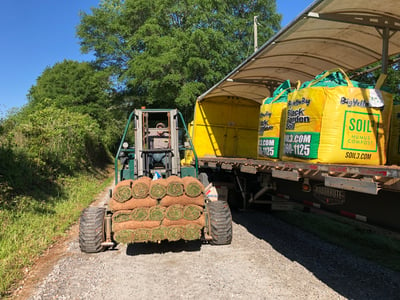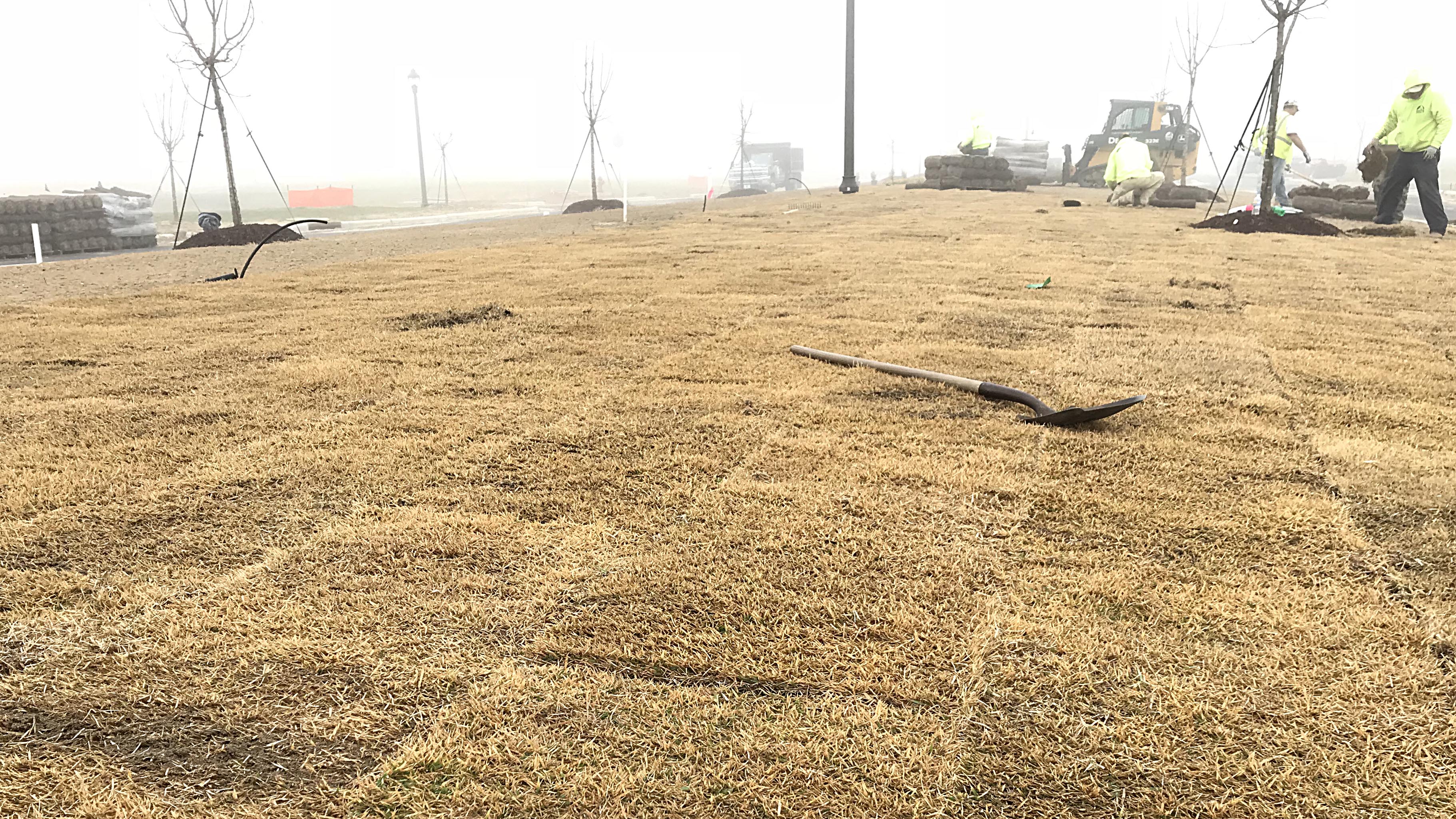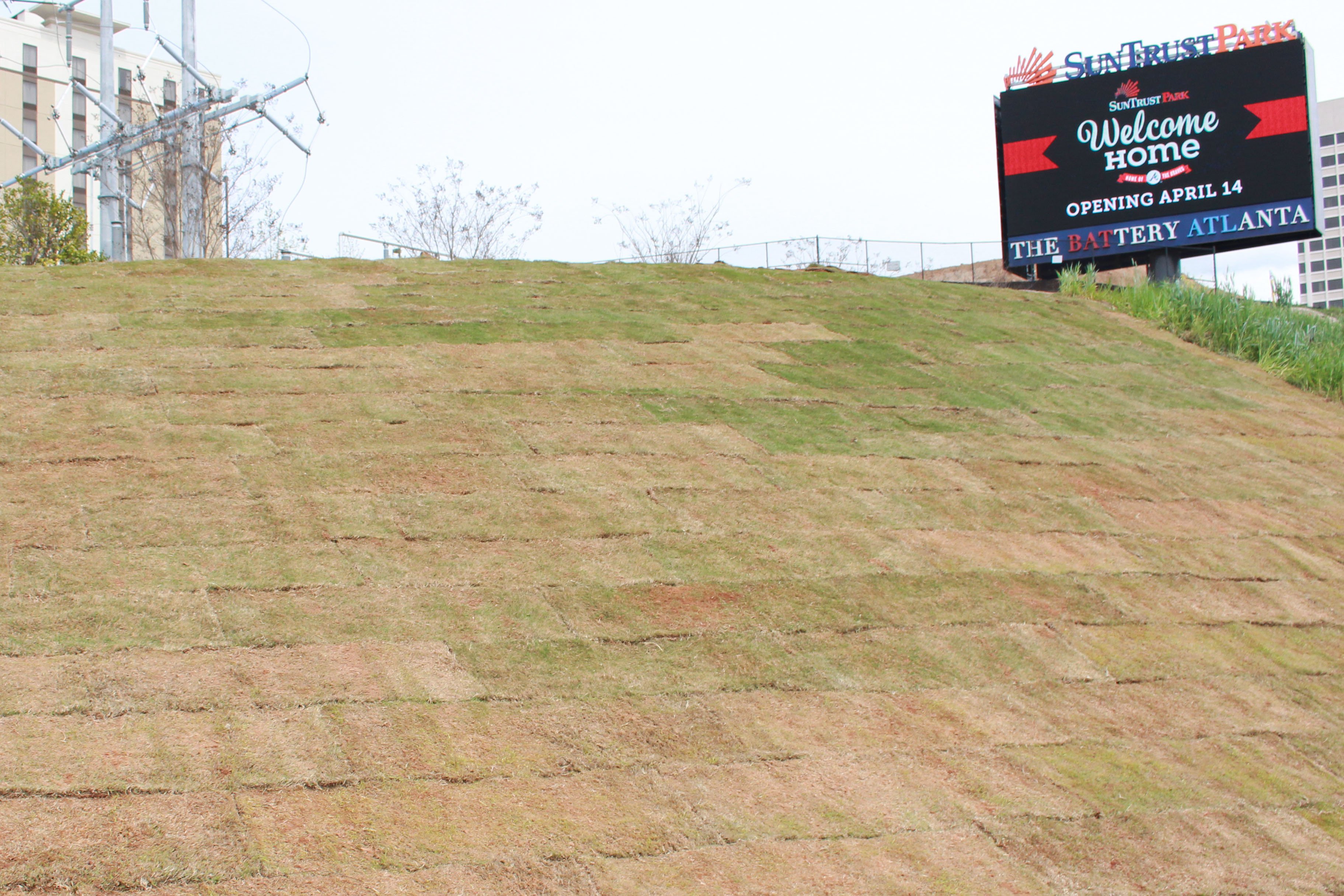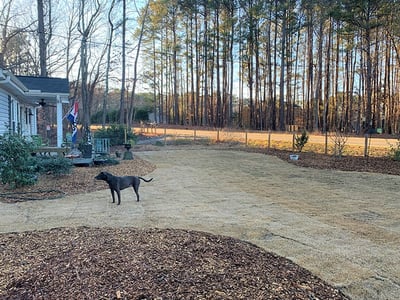

Are you sure that’s going to grow? It doesn’t look like it’s gonna make it.
Yes, we are sure that if you lay sod in winter it's going to thrive! In this article we'll explain about installing cool season Tall Fescue (green during winter) and dormant warm season (brown during winter) grasses during winter.
We've written a supporting article dedicated specifically to how to lay dormant sod, with specific considerations for dormant warm season sod.
Why Lay Sod in Winter?
The question of laying turf in winter comes up with new home construction where there is plenty of bare dirt and move-in coincides with the dead of winter. One of the conditions for a certificate of occupancy is that the bare ground of a construction site has plants growing on it to stabilize the soil and prevent erosion.
Laying sod in the winter quickly and easily solves this problem and gets you over another hurdle.

Laying dormant sod on the lawn of a new house helps move-in happen more quickly.
Types to Install During Winter
Warm Season Sod
Even though warm season turf like Zoysia, Centipede, and Bermudagrass is dormant and brown (think hibernating) in the fall or winter, you can still lay most types on the bare soil of your lawn. Even though it's dormant, it still prevents erosion and muddy areas during the winter.
Cool Season Tall Fescue
Did you know that in the South laying Tall Fescue in fall and winter is the ideal time to lay this cool season grass? When temperatures warm up in the spring, we recommend holding off installing new Tall Fescue sod until the autumn.

Measure the Lawn Area
Calculate the amount of sod you’ll need with the following formula:
length x width = square feet of sod needed
Be sure to subtract space for areas such as buildings or driveways.
If you’re having trouble with odd-shaped areas, use our Lawn Area Calculator.
Prepare Your Soil
Kill off any existing grass, then till up your lawn to a depth of 4-6 inches. When laying sod in winter, you may have to rent a sod cutter to remove the vegetation rather than relying on herbicide. Level it out, then add soil amendments such as Soil3 compost or fertilizer from the result of a soil test.
How to Lay Sod in Winter
First, read steps 1-5 of How to Lay Sod and follow those instructions. Then keep in mind these three pointers for laying both dormant warm season and green Tall Fescue sod in winter.
Lay it Perpendicular to Slopes: If laying sod in the winter on a slope, lay the sod rolls perpendicular to the slope itself. This will help it stay in place and the weight of the sod will help prevent soil erosion before the grass takes root (for dormant sod, it will root in the spring).
Use sod staples (long U-shaped pins) to tack down the new sod and help it stay in place until it roots in the spring. Sod staples are especially helpful when laying sod on slopes.
Roll It: Roll your new sod with a sod roller rented from your local equipment rental. Fill the roller with water and roll back and forth in a grid-like pattern. This does away with air pockets and helps prevent roots from drying out and winter damage.
Freezing Facts: If your sod is rolled and watered properly until it roots, freezing temperatures will not hurt it.
We linked to it above, but here's a reminder that we wrote a supporting article dedicated specifically to how to lay dormant sod.
Watering New Sod Through Winter
Just as in the spring and summer, you’ll need to water sod immediately after it is installed. This applies to both Tall Fescue and dormant warm season sod. Even if it’s dormant, you’ll then need to keep it moist until it takes root in the spring and greens up.
Pay attention to the weather and observe your new sod daily. Watering in the winter is a balancing act, just like in the summer, but for different reasons.
- Installing dormant sod uses less water than installing a warm season grass in the summer.
- If it's going to be below freezing, turn off your irrigation and drain the lines so pipes, hoses, and sprinkler heads don't burst. No need to water when it's freezing because plants aren't taking up water anyway. If you're going to be away or you haven't watered for a few days, then watch the weather and water new sod a day before a freeze.
- However, a cold, dry wind can dry out roots quickly and desiccate your new installation so observe your lawn to water accordingly.
Watch Your Warm Season Sod Green Up in the Spring
Once the ground temperatures rise to an appropriate level, your warm season sod will begin to take root and green up. After spring green up, follow the lawn maintenance instructions for your variety of grass.

This picture shows two details 1) sod laid perpendicular to the slope and 2) how spring green up can be uneven - warm air rises so the sod at the top of the slope is greening up earlier than sod further down the slope where it’s colder.
Winter Installation Advantages
I’ll leave you with one final secret of installing sod during winter: the delivery schedule doesn’t fill up as quickly when you order in the winter. While we recommend ordering 2-5 days before installation, delivery schedules for the week can fill up much more quickly once signs of spring appear.
If you’re not the DIY type, landscapers often have lighter schedules in the winter as well.
Got questions? Leave a comment below.
Ready for sod? Order online.
New here? Subscribe to our emails to get this information in your inbox every month.
More importantly, thank you for reading and learning about farm fresh sod, your best choice for curb appeal and quick property upgrades.







